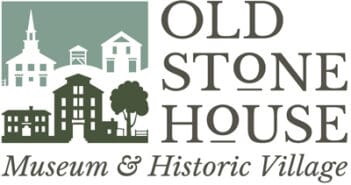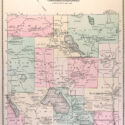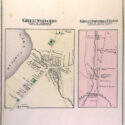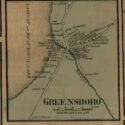Town Facts
- Granted to Timothy Green in 1781
- Caspian Lake, a 739-acre body of water in the southern part of the town, is a vacation spot for academics and professionals such as John Gunther and William H. Rehnquist, a former Supreme Court Chief Justice
Town History
From the Vermont Historical Gazetteer, edited by Abby Maria Hemenway. Orleans County – Greensboro Chapter: By Rev. James P. Stone. Published by Claremont Manufacturing Co, 1877. Pgs 209-215.
At the eastern extremity of the Caspian, and just below its outlet, is the beautiful little village of Greensboro, where there are some 25 neat dwellings, a hotel, 3 or 4 stores, excellent mills for sawing and grinding, also several shops where mechanical business of divers [sic] sorts is carried on, 2 churches, Congregational and Presbyterian, the town house and school-house.
Such is Greensboro at the present day. But such it once was not. Less than one hundred years, this town and all the surrounding country was an unbroken wilderness. Then “the red man of the forest” might here erect his wigwam, pursue his game, or launch his light canoe, with no fear of being molested by men boasting a higher degree of civilization; or in his absence, the wild bear, the deer and the moose might roam through these forests unscared. But time rolls on, and anon new visions meet the eye. The sound of the axe is heard, announcing the approach of civilized men. The Red Man retreats, the wild beasts retire, the thick forest is soon converted into a fruitful field, and neat and comely dwellings succeed the smoky wigwam.
As early as during the year 1776, in the midst of the Revolutionary struggle, the road was commenced by Gen. Bailey, which was, in 1779, extended and rendered passable, through Cabot, Walden, Hardwick, Greensboro, Craftsbury, Albany to Lowell, and called the Hazen road. Upon this road, at different points, were erected block-houses, designed to serve as forts. One of these was in Greensboro, on the western side of the Capsian, on what was for many year known as the Cushing, and more recently as the William’s farm.
In the summer of 1781, a party of the enemy from Canada, having been to Peacham and made prisoners of Jacob Page, Col. Johnson and Col. Elkins, then a youth, Capt. Nehemiah Loveland, with his company, was stationed there for the protection of the inhabitants. In September, he sent a scout of four men up the Hazen road. They proceeded as far as Greensboro, where, while occupying the block-house above referred to, in an unguarded hour, while at a little distance from it, they were attacked by a party of Indians, and two of them, viz. Bliss of Thetford, and Moses Sleeper of Newbury, were shot down and scalped. Their companions, having offered no resistance, were led captives to Canada, and soon found themselves prisoners with Elkins of Peacham. It was not till their return that the fate of Bliss and Sleeper were known by their friends, a party of whom at once proceeded to Greensboro; found the remains undisturbed, but in that loathsome condition naturally consequent upon long exposure to the weather. A grave was dug, and the putrid masses, uncoffined, were rolled in and buried. And there, this day, in calm repose they rest. No monument has ever been erected, sacred to their memory; and the traveler passes near the spot without being reminded, or so much as knowing that there once fell, in their country’s service, two of her worthy sons.
In November, 1780, the township was granted, and Aug. 20, 1781, chartered to Harris Colt and 66 associates. It was first names Coltshill, in honor of Mr. Colt. The name was afterwards changed to Greensboro, in honor of Mr. Green, one of the proprietors, and as being more euphonic.
It was not till several years subsequent to this, that attempts were made for permanent settlements here, nor is it known that during these years white men visited the place except in the capacity of huntsmen. There was the might hunter, Lyford of Cabot, who spent much time in the vicinity of the Caspian, having his camps at different points along the shore, the precise locations of some of which, it is said, can be pointed out to the visitor at the present day. Near one of these spots, not far from the north-western extremity of the lake, is a spring of water still known as the Lyford spring.
It was in one of those Lyford camps that the Rev. Messrs. Tolman and Wood found shelter, as they spent three days and nights in this wilderness, offering fervent and earnest prayers to God for the place and its future inhabitants. This was this soil religiously consecrated, and Jehovah invoked to be the God of those who should afterwards dwell upon it, while as yet, not a single building was erected, or a field cleared, and while not a single human being could say, “this is my home.”
In December of the following year, 1788, was held at Cabot, a meeting of the proprietors of Greensboro, in attempting to attend which, one of them, Timothy Stanley lost a portion of his foot by frost. For want of surgical instruments, it is said that his toes and the lower part of his foot were removed by means of mallet and chisel, and that too, quite successfully.
During the following Spring, settlements were commenced in Greensboro. From Newbury, then called Coos, in the Spring of 1789, came to Greensboro, Messrs. Ashbel and Aaron Shepard with their families. From Cabot Plain, a distance of 16 miles, the women had to proceed on foot, and all the furniture for both families was drawn on three handsleds. The families consisted of but five persons. Viz. Ashbel Shepard and wife, and Aaron Shepard and wife and one child. Aaron and family went into the block-house, formerly designed as a fort; Ashbel erected a log-cabin and began further south, on what has since been known as the Rand farm.
But, in August, Aaron Shepard returned to Newbury, leaving his brother Ashbel and wife through the winter as the sole inhabitants of the town, during which time their nearest neighbors were, Mr. Benjamin Webster in Cabot, Mr. Nathan Cutler in Craftsbury, then called Minden. At the same time, Col. Crafts and Mr. Trumball, having for the winter left Minden, the Cutler family was the only family in that town; and the two constituted for a time, the entire population within the present limits of Orleans County.
During this season of loneliness, the two families, of Greensboro and Minden, were cheered by an arrival, not of the cars, nor of a stage coach, nor yet of chaise, wagon or sleigh; but of a hand-sled, drawn by three cheerly young men, and bearing upon it a precious burden, a healthful, comely girl of not quite 14 years. She was the step-daughter of Mr. Cutler in Minden. From Sturbridge, Mass., where a year before she was left by her parents for the purpose of attending school, she was in Jan., 1790, brought on her way by Col. Joseph Scott as far as Ryegate, Vt. Having been detained some 2 weeks at Ryegate, at the house of Squire Page, she was by him conveyed to the house of Dea. Elkins in Peacham. After a delay there of another 2 weeks, she was enabled to advance a little further. Hon. Aaron Robinson of Bennington, brought her to the house of Squire Levensworth in Dewey’s Gore, which now constitutes parts of Danville and Peacham; there she was subjected to another delay of ten days, when she came on horseback to the house of Lieut. Lyford on Cabot plain, and the next morning proceeded as before described towards Minden, drawn by Jesse Levensworth, Josiah Elkins, and Obed Cutler, a son of her step-father. The party reached the house of Mr. Shepard, the only house between Cabot and Minden, about noon. It hardly need be said that Mrs. Shepard, in the absence of her husband for a hand-sled load of hay, gave them a hearty greeting, and as comfortable a dinner as circumstances would allow. Cheered and refreshed, the party proceeded on their way, and just as the sun was going down, reached the house of the parents of Obed Cutler and Mary Gerould. For months previous to this, no female had been seen by Mrs. Shepard or Mrs. Cutler.
Those families have long since passed away. But that daughter afterward lived 70 years in Greensboro, where she died in the autumn of 1864, and is still remembered with interest and affection even by the youth and children, and spoken of by the endearing appellation, “Grandma’am Stanley.”
March 29, 1793, the town was organized, the first town meeting being held at the house of Ashbel Shepard. The precise time of arrival of each of the first settlers it is impossible to ascertain.
Public roads have become sufficiently numerous. It is said that the first ever laid through the town after its settlement was the old road to Glover, formerly known as the Norton road, and that was done through the agency of Cap. Hinman, who was anxious to prepare the way for the settlement of Derby, by extending it to that town, in which he finally succeeded. That old Norton road, up to the time of the running away of the great pond in 1810, and the subsequent laying of the road through its bed, called the Runaway Pond Road, was the principal thoroughfare between Central and Northern Vermont; but has since been superseded by others, and is comparatively little known to travelers.
Of schools, the first ever taught in Greensboro was in the Summer of 1794, in Aaron Shepard’s barn. The teacher was Miss Anita Hill, who also taught, the following Summer in the barn of Ashbel Shepard. In the same place soon after, Miss Eunice Stoddard, taught a school. She afterwards became the wife of Col. Elkins of Peacham. The third teacher ever employed in the town was Miss Jane Johnson, who occupied the first schoolhouse ever built in Greensboro, which stood on an eminence on the old road from Greensboro village to Hardwick street. That house, not many years after, was destroyed by fire; but another was soon built on, or near the same spot, afterwards known as the South school-house, to distinguish it from another also built at an early date, known as the North school-house, still standing, in a dilapidated condition, a little north of the center of the town. Since those days schools have multiplied, so that instead of one or two, the No. of school districts in 1850, was 15, in most of which, schools were sustained both Summer and Winter.
In regard to general health, Greensboro has usually been considered as, favorably located. Some of its inhabitants have lived to a great age. A Mr. Bush who died in March 1845, was supposed, by his children, to have reached his 115 years. For many years the place has been much visited by persons from abroad in quest of health. But here as well as elsewhere have been from the first, sickness and death. The first adult person who was by death removed from among the inhabitants, was Mrs. Hill, wife of Dea. Peleg Hill. In the year 1802, from 7 families, 14 persons were suddenly removed by dysentery. Scarcely had this season of terrible distress passed away, when small pox, was introduced, occasioning very much suffering, and by which two or three children, of the families James Hill and Jonathan Nay, died.
As, for many years, since those early days, no record of the deaths in town was kept, or at least that can now be found; of the mortality from the first, nothing definite can be ascertained.*
*(The town records were destroyed by fire, with the store, and extensive stock of goods, belonging to Storrs and Langdon, Aug. 9, 1831. There was another extensive conflagration, Dec. 6, 1838, when the large store of Babbitt and Gleason, on the ground where is now the store of A. C. Babbitt, was consumed, with 7 or 8 other buildings. The fire originated, as was supposed, in Col. Steven’s oat-mill.)
But the writer of this sketch, having been 11 years a pastor in Greensboro, remembers, that during those years, ending with December 1861, he had recorded the names of 200 of the inhabitants, who had during those years been removed by death.




